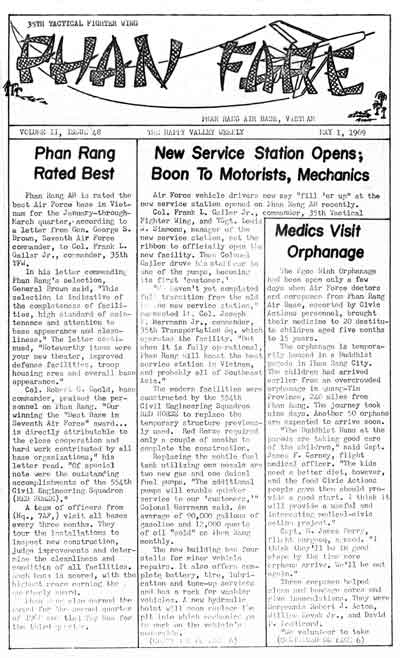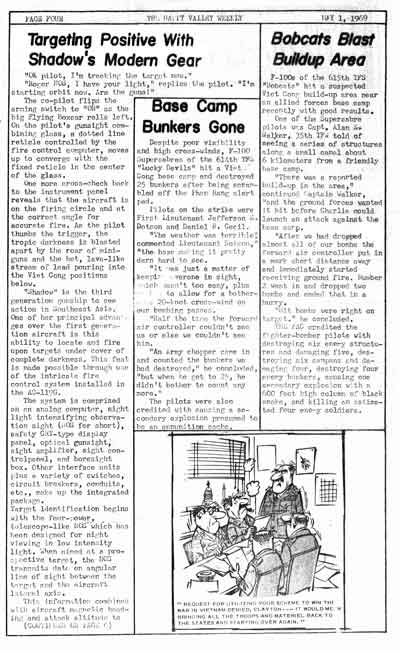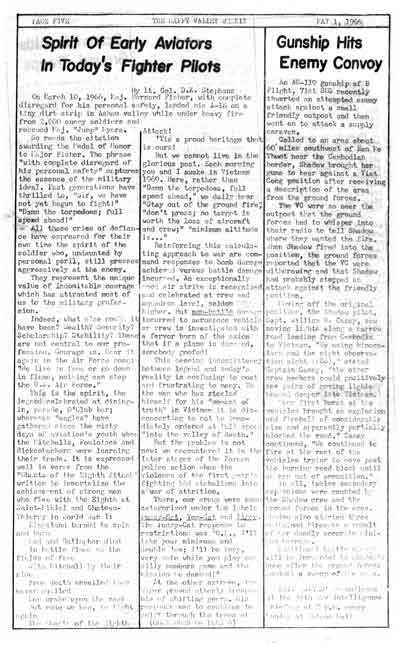Excerpts from the May 1, 1969
issue of Phan Fare,
The Happy Valley Weekly

|
Phan Rang Rated
Best
Phan Rang AB is rated the best
Air Force base in Vietnam for the January-through March quarter,
according to a letter from Gen. George S. Brown, Seventh Air
Force Commander, to Col. Frank L. Gailer Jr., commander, 35th
TFW. In his letter commending Phan Rang's selection, General
Brown said,"This selection is indicative of the completeness
of facilities, high standard of maintenance and attention to
base appearance and cleanliness." The letter continued,
"Noteworthy items were your new theater, improved defense
facilities, troop housing area, and overall base appearance."
Col. Robert C. Goold Base Commander,
praised the personnel on Phan Rang. "Our winning the 'Best
Base in the Seventh Air Force' award is directly attributable
to the close cooperation and hard work contributed by all base
organizations," his letter read. "Of special note were
the outstanding accomplishments of the 554th Civil Engineering
Squadron (RED HORSE).
A team of officers from Hq.
7th AF visit all bases every three months. They tour the installations
to inspect new construction, judge improvements, and determine
the cleanliness and condition of all facilities. Each base is
scored, with the highest score earning the quarterly award. Phan
Rang also earned the award for the second quarter of 1968 and
tied Tuy Hoa for the third quarter.
|

|
Targeting Positive
With Shadow's Modern Gear
"OK pilot, I'm tracking
the target now." "Roger NOS, I have your light,"
replies the pilot. "I'm starting orbit now. Arm the guns!"
The co-pilot flips the arming switch to "ON" as the
big 'Flying Boxcar' rolls left. On the pilot's gunsight combining
glass, a dotted line reticle controlled by the fire control computer
moves up to converge with the fixed reticle in the center of
the glass.
One more cross check back to
the instrument panel reveals that the aircraft is on the firing
circle and at the correct angle for accurate fire. As the pilot
thumbs the trigger, the tropic darkness is blasted apart by the
roar of mini-guns and the hot lava-like stream of lead pouring
into the Viet Cong positions below.
"Shadow" is the third
generation gunship to see action in Southeast Asia. One of her
principal advantages over the first generation gunship is this
ability to locate and fire upon targets under cover of complete
darkness. This feat is made possible through use of the intircate
fire control system installed in the AC-119G.
The system is comprised of
an analog computer, night observation sight (NOS), safety CRT-type
display panel, optical gunsight, sight amplifier, sight control
panel, and boresight box. Other interface units plus a variety
of switches, circuit breakers, conduits, etc., make up the integrated
package. Target identification begins with the four-power telescope-like
NOS which has been designed for night viewing in low intensity
light. When aimed at a prospective target, the NOS transmits
data on angular line of sight between the target and the aircraft
lateral axis.
This information combiles with
aircraft magnetic heading and attack altitude to compute the
aircraft-target relationship and thereby position a moving reticle
- representing the target - for the pilot's viewing. Three modes
of firing are avaliable for selection at the pilot's discretion.
Of these, two utilize full system operation while the third,
manual, involves only the pilot's gunsight. "Being able
to fly 'black-out'," relates one Shadow crew member, "has
allowed us to catch a number of VC/NVA trucks flat-footed. With
their engines running, they can't hear us; and without using
lights or illumination, they don't know we're around until that
mini-gun firepower comes ripping from the sky."
|

|
Gunship Hits
Enemy Convoy
An AC-119 gunship of 'B'
Flight, 71st SOS recently thwarted an attempted enemy attack
against a small outpost and then went on to attack a supply caravan.
Called to an area about 60 miles southwest of Ban He Thoat near
the Cambodian border, Shadow brought her guns to bear against
a Viet Cong position after receiving a description of the area
from the ground forces.
The VC were so near the
outpost that the ground forces had to whisper into their radio
to tell Shadow where they wanted the fire. When Shadow fired
into the position, the ground forces reported the VC were withdrawing
and that Shadow probably stopped an attack against the friendly
position.
Moving off the original
position, the Shadow pilot Capt. Wm. Casey saw moving lights
along a narrow road leading from Cambodia to Vietnam. "By
using binoculars and the Night Observation Sight (NOS),"
stated Captain Casey, "the other crew members could positively
see pairs of moving lights headed deeper into Vietnam."
"Our first burst at the vehicles brought an explosion and
fireball of considerable size that apparently blocked the road."
Casey continued, "We continued to fire at the rest of the
vehicles trying to move past the burning road block until we
ran out of ammunition."
In all, twelve secondary
explosions were counted by the Shadow crew and the ground forces
in the area. Shadow also started three sustained fires as a result
of her deadly accurate mini-gun barrage. Additional battle damage
will be forwarded to Shadow's home after the ground forces conduct
a sweep of the area.
|
BACK
|





